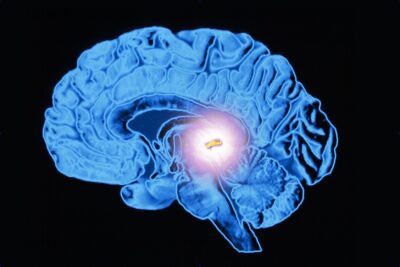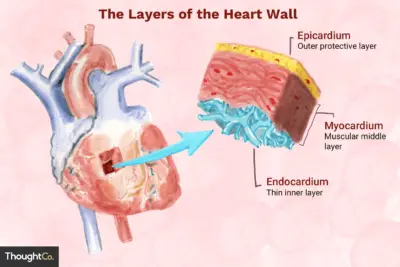
Respiration is the process in which organisms exchange gases between their body cells and the environment. From prokaryotic bacteria and archaeans to eukaryotic protists, fungi, plants, and animals, all living organisms undergo respiration. Respiration may refer to any of the three elements of the process.
First, respiration may refer to external respiration or the process of breathing (inhalation and exhalation), also called ventilation. Secondly, respiration may refer to internal respiration, which is the diffusion of gases between body fluids (blood and interstitial fluid) and tissues. Finally, respiration may refer to the metabolic processes of converting the energy stored in biological molecules to usable energy in the form of ATP. This process may involve the consumption of oxygen and production of carbon dioxide, as seen in aerobic cellular respiration, or may not involve the consumption of oxygen, as in the case of anaerobic respiration.
Key Takeaways: Types of Respiration
- Respiration is the process of gas exchange between the air and an organism's cells.
- Three types of respiration include internal, external, and cellular respiration.
- External respiration is the breathing process. It involves inhalation and exhalation of gases.
- Internal respiration involves gas exchange between the blood and body cells.
- Cellular respiration involves the conversion of food to energy. Aerobic respiration is a cellular respiration that requires oxygen while anaerobic respiration does not.
Lectura relacionada:
 Protista Kingdom - Definition, Characteristics, and Examples
Protista Kingdom - Definition, Characteristics, and ExamplesTypes of Respiration: External and Internal
When inhaling, the diaphragm contracts and the lungs expand, pushing the chest upwards. When exhaling the diaphragm relaxes and the lungs contract, moving the chest back down.
wetcake/DigitalVision Vectors/Getty Images
External Respiration
One method for obtaining oxygen from the environment is through external respiration or breathing. In animal organisms, the process of external respiration is performed in a number of different ways. Animals that lack specialized organs for respiration rely on diffusion across external tissue surfaces to obtain oxygen. Others either have organs specialized for gas exchange or have a complete respiratory system. In organisms such as nematodes (roundworms), gases and nutrients are exchanged with the external environment by diffusion across the surface of the animals body. Insects and spiders have respiratory organs called tracheae, while fish have gills as sites for gas exchange.
Lectura relacionada: Etapas y Proceso de Replicación del ADN
Etapas y Proceso de Replicación del ADNHumans and other mammals have a respiratory system with specialized respiratory organs (lungs) and tissues. In the human body, oxygen is taken into the lungs by inhalation and carbon dioxide is expelled from the lungs by exhalation. External respiration in mammals encompasses the mechanical processes related to breathing. This includes contraction and relaxation of the diaphragm and accessory muscles, as well as breathing rate.
Internal Respiration
External respiratory processes explain how oxygen is obtained, but how does oxygen get to body cells? Internal respiration involves the transportation of gases between the blood and body tissues. Oxygen within the lungs diffuses across the thin epithelium of lung alveoli (air sacs) into surrounding capillaries containing oxygen depleted blood. At the same time, carbon dioxide diffuses in the opposite direction (from the blood to lung alveoli) and is expelled. Oxygen rich blood is transported by the circulatory system from lung capillaries to body cells and tissues. While oxygen is being dropped off at cells, carbon dioxide is being picked up and transported from tissue cells to the lungs.
Lectura relacionada:
 Comparación y contraste: Fisión binaria vs. Mitosis
Comparación y contraste: Fisión binaria vs. MitosisCellular Respiration
The three processes of ATP production or celluar respiration include glycolysis, the tricarboxylic acid cycle, and oxidative phosphorylation.
Credit: Encyclopaedia Britannica/UIG/Getty Images
The oxygen obtained from internal respiration is used by cells in cellular respiration. In order to access the energy stored in the foods we eat, biological molecules composing foods (carbohydrates, proteins, etc,) must be broken down into forms that the body can utilize. This is accomplished through the digestive process where food is broken down and nutrients are absorbed into the blood. As blood is circulated throughout the body, nutrients are transported to body cells. In cellular respiration, glucose obtained from digestion is split into its constituent parts for the production of energy. Through a series of steps, glucose and oxygen are converted to carbon dioxide (CO2), water (H2O), and the high energy molecule adenosine triphosphate (ATP). Carbon dioxide and water formed in the process diffuse into the interstitial fluid surrounding cells. From there, CO2 diffuses into blood plasma and red blood cells. ATP generated in the process provides the energy needed to perform normal cellular functions, such as macromolecule synthesis, muscle contraction, cilia and flagella movement, and cell division.
Aerobic Respiration
This is diagram of aerobic cellular respiration including glycolysis, Krebs cycle (citric acid cycle), and the electron transport chain.
RegisFrey/Wikimedia Commons/CC BY-SA 3.0
Aerobic cellular respiration consists of three stages: glycolysis, citric acid cycle (Krebs Cycle), and electron transport with oxidative phosphorylation.
- Glycolysis occurs in the cytoplasm and involves the oxidation or splitting of glucose into pyruvate. Two molecules of ATP and two molecules of the high energy NADH are also produced in glycolysis. In the presence of oxygen, pyruvate enters the inner matrix of cell mitochondria and undergoes further oxidation in the Krebs cycle.
- Krebs Cycle: Two additional molecules of ATP are produced in this cycle along with CO2, additional protons and electrons, and the high energy molecules NADH and FADH2. Electrons generated in the Krebs cycle move across the folds in the inner membrane (cristae) that separate the mitochondrial matrix (inner compartment) from the intermembrane space (outer compartment). This creates an electrical gradient, which helps the the electron transport chain pump hydrogen protons out of the matrix and into the intermembrane space.
- The electron transport chain is a series of electron carrier protein complexes within the mitochondrial inner membrane. NADH and FADH2 generated in the Krebs cycle transfer their energy in the electron transport chain to transport protons and electrons to the intermembrane space. The high concentration of hydrogen protons in the intermembrane space is utilized by the protein complex ATP synthase to transport protons back into the matrix. This provides the energy for the phosphorylation of ADP to ATP. Electron transport and oxidative phosphorylation account for the formation of 34 molecules of ATP.
In total, 38 ATP molecules are produced by prokaryotes in the oxidation of a single glucose molecule. This number is reduced to 36 ATP molecules in eukaryotes, as two ATP are consumed in the transfer of NADH to mitochondria.
Fermentation
Alcoholic and Lactate Fermentation Processes.
Vtvu/Wikimedia Commons/CC BY-SA 3.0
Aerobic respiration only occurs in the presence of oxygen. When oxygen supply is low, only a small amount of ATP can be generated in the cell cytoplasm by glycolysis. Although pyruvate can not enter the Krebs cycle or electron transport chain without oxygen, it can still be used to generate additional ATP by fermentation. Fermentation is another type of cellular respiration, a chemical process for the breakdown of carbohydrates into smaller compounds for the production of ATP. In comparison to aerobic respiration, only a small amount of ATP is produced in fermentation. This is because glucose is only partially broken down. Some organisms are facultative anaerobes and can utilize both fermentation (when oxygen is low or not available) and aerobic respiration (when oxygen is available). Two common types of fermentation are lactic acid fermentation and alcoholic (ethanol) fermentation. Glycolysis is the first stage in each process.
Lactic Acid Fermentation
In lactic acid fermentation, NADH, pyruvate, and ATP are produced by glycolysis. NADH is then converted to its low energy form NAD+, while pyruvate is converted to lactate. NAD+ is recycled back into glycolysis to generate more pyruvate and ATP. Lactic acid fermentation is commonly performed by muscle cells when oxygen levels become depleted. Lactate is converted to lactic acid which can accumulate at high levels in muscle cells during exercise. Lactic acid increases muscle acidity and causes a burning sensation that occurs during extreme exertion. Once normal oxygen levels are restored, pyruvate can enter aerobic respiration and much more energy can be generated to aid in recovery. Increased blood flow helps to deliver oxygen to and remove lactic acid from muscle cells.
Alcoholic Fermentation
In alcoholic fermentation, pyruvate is converted to ethanol and CO2. NAD+ is also generated in the conversion and gets recycled back into glycolysis to produce more ATP molecules. Alcoholic fermentation is performed by plants, yeast, and some species of bacteria. This process is used in the production of alcoholic drinks, fuel, and baked goods.
Anaerobic Respiration
Bifidobacteria are Gram-positive anaerobic bacteria that live in the gastrointestinal tract.
KATERYNA KON/Science Photo Library/Getty Images
How do extremophiles like some bacteria and archaeans survive in environments without oxygen? The answer is by anaerobic respiration. This type of respiration occurs without oxygen and involves the consumption of another molecule (nitrate, sulfur, iron, carbon dioxide, etc.) instead of oxygen. Unlike in fermentation, anaerobic respiration involves the formation of an electrochemical gradient by an electron transport system that results in the production of a number of ATP molecules. Unlike in aerobic respiration, the final electron recipient is a molecule other than oxygen. Many anaerobic organisms are obligate anaerobes; they don't perform oxidative phosphorylation and die in the presence of oxygen. Others are facultative anaerobes and can also perform aerobic respiration when oxygen is available.












